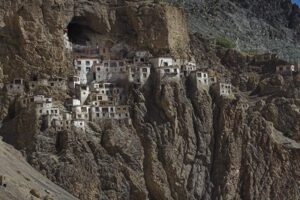
Phuktal Gonpa is a Buddhist monastery located in the remote Lungnak Valley of Zanskar, in the region of Ladakh, Northern India. Built around a natural cave believed to have been visited by important sages, scholars and translators beginning around 2,550 years ago, the present Phuktal Gonpa of the Gelug lineage was established in the early 14th century by Jangsem Sherap Zangpo, a disciple of Gelug founder Tsongkhapa.
Phuktal Gonpa owes its distinguished legacy of powerful scholars and teachers to the cave, which has long been a place of retreat, meditation, learning, and teaching. The name Phuktal (or Phukthal) reflects this, coming from the two words “Phuk” meaning cave, and “tal” or “thal” meaning “at leisure”; a second spelling of Phuktal is Phukthar – “thar” meaning liberation
Among the earliest residents of Phuktal cave were the 16 “Arhats” or legendary followers of Buddha, whose images appear on the cave’s walls. The great scholar-translators Padmasambhava and Phakspa Nestan Dusdan are said to have resided in the cave; Milarespa’s teacher Lama Marpa also stayed in the Phuktal cave. In the 12th century, the scholar and Tibetan translator Zanskar – Lotsawa Phagpa Sherab lived and worked here. The three eminent scholar- brothers Dangsong – Pun – Sum, believed to hold the supernatural power of flight, gave Dharma teachings here; upon the arrival of Jangsem Sherap Zangpo, they departed, bequeathing the sacred site to him. According to legend, the spiritually gifted Zangpo caused a spring to run in the cave, a tree to grow above the cave, and the cave itself to grow larger. Then, under his guidance, the present monastery was built. Today the Phuktal Gonpa houses a main temple, prayer rooms, a library, numerous apartments, teaching facilities, a kitchen, and of course the original cave and protected sacred spring.
Source:


